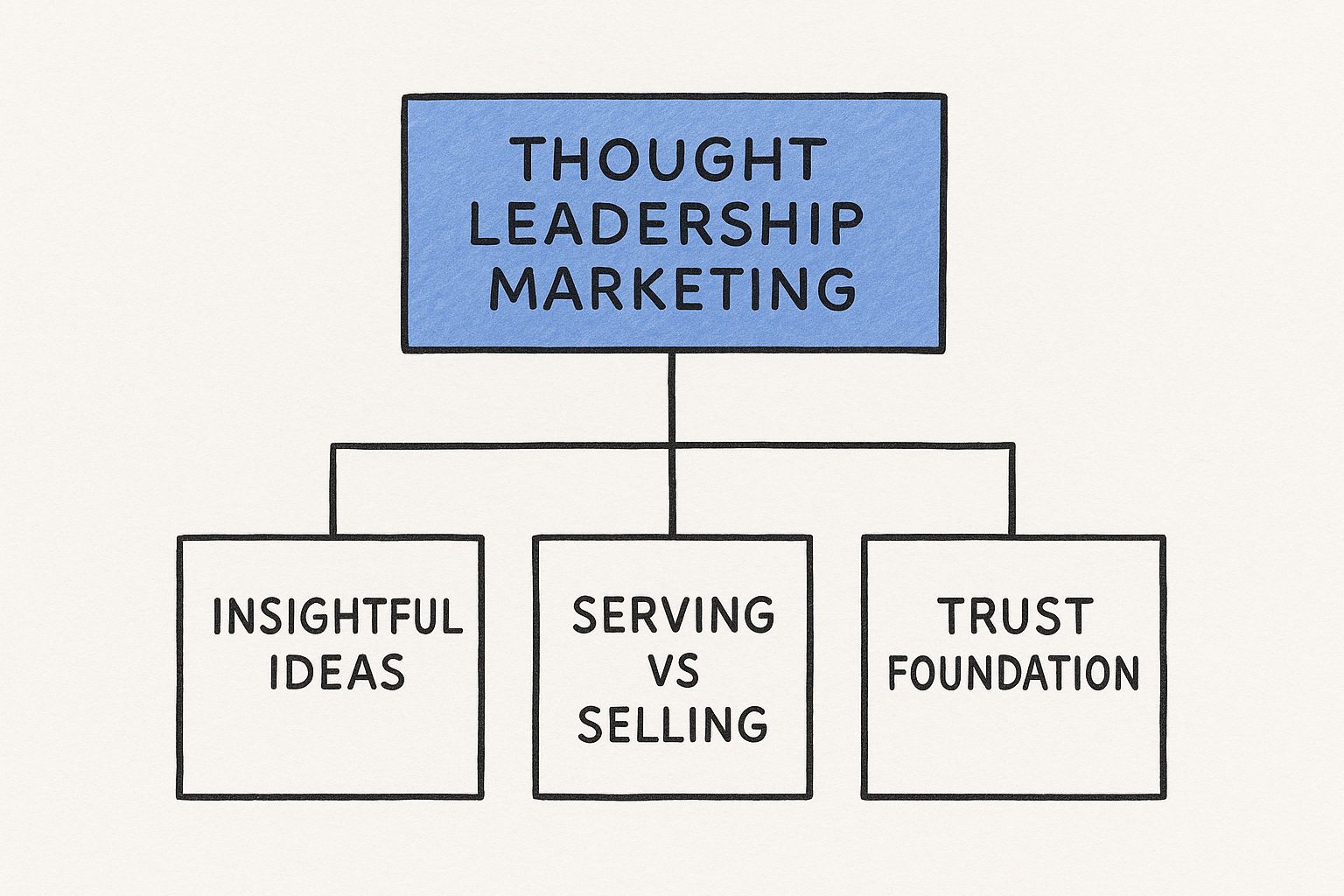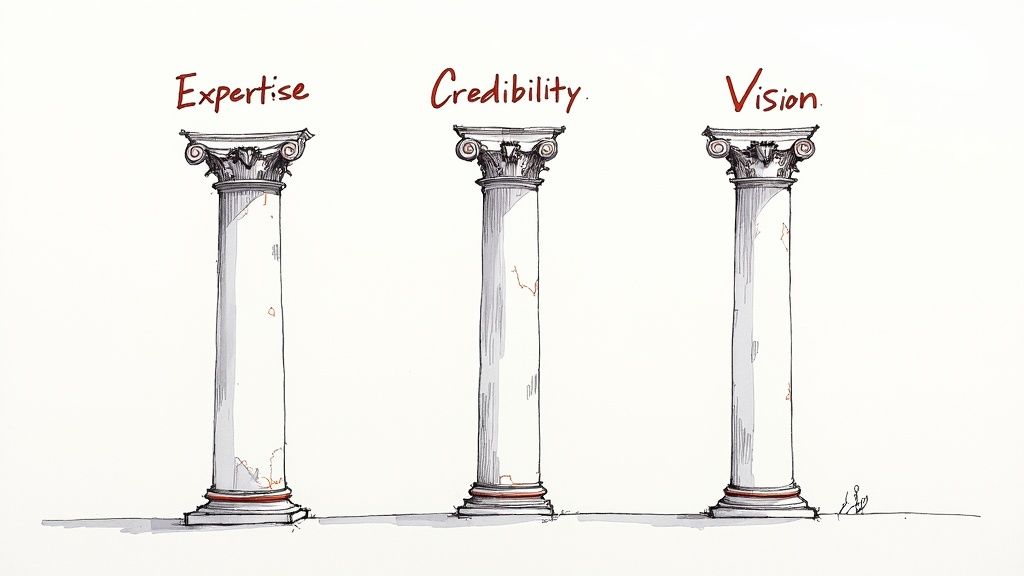What Is Thought Leadership Marketing and How Does It Work
October 13, 2025

Thought leadership marketing is all about positioning yourself or your company as the go-to foremost expert in your field. It’s less about direct selling and more about consistently sharing valuable, forward-thinking ideas that genuinely serve your audience.
Going Beyond The Buzzword What Is Thought Leadership Marketing
It’s easy to mix up thought leadership with regular content marketing, but they really are two different beasts. Standard content marketing is often designed to attract and educate with a clear path toward a sale. Thought leadership, on the other hand, is a long-term play focused on building a deep foundation of trust.
Think of it this way: imagine you’re about to climb a treacherous mountain. Who do you hire as your guide? Not the one who just shoves a glossy brochure in your face. You’re going to pick the guide who has literally written the book on that mountain, shares weekly insights on its weather patterns, and is known for spotting trail hazards before they even become a problem. That guide didn't try to sell you anything, but their undeniable expertise made them the only choice.
That’s exactly how thought leadership works. It shifts your brand’s role from just another vendor to an indispensable resource.
This is all accomplished by:
- Sharing a Unique Perspective: Don't just rehash what everyone else is saying. Bring something new to the table—a fresh take on a stubborn problem or a prediction about a trend no one else sees coming.
- Prioritizing Value Over Promotion: The main goal of your content should be to help your audience. Whether it's solving a problem or explaining a complex topic, your product or service should take a backseat.
- Building a Reputation for Credibility: When you consistently put out accurate, well-researched, and genuinely helpful content, you build authority that stands the test of time.
This diagram breaks down the core components of this approach.

As you can see, it all starts with insightful ideas that drive a service-first mindset, which ultimately earns the trust of your audience.
Thought leadership isn't about having all the answers; it's about asking the right questions and guiding the conversation in your industry. It transforms your brand from a participant into a leader.
So, what is thought leadership marketing at its core? It's the art of becoming so valuable to your audience that when they finally need a solution like yours, you're the first—and maybe only—name that comes to mind. It's about earning your influence through expertise, not just buying it with ads.
Thought Leadership vs Traditional Content Marketing
While they often work together, it's helpful to see how these two strategies differ in their goals and execution. Here’s a quick breakdown:
| Aspect | Thought Leadership Marketing | Traditional Content Marketing |
|---|---|---|
| Primary Goal | Build trust, authority, and influence. Shape industry conversation. | Generate leads, drive website traffic, and support sales. |
| Focus | Answering the "why" and "what if." Exploring future trends. | Answering the "what" and "how." Providing practical solutions now. |
| Content Style | Opinionated, forward-looking, based on unique data or experience. | Informative, educational, often focused on brand-specific features. |
| Audience Relationship | Creates a community of followers who trust your perspective. | Attracts an audience looking for a specific answer or solution. |
| Key Metric | Influence, share of voice, brand mentions, inbound links. | Leads generated, conversion rates, time on page, SEO rankings. |
Ultimately, traditional content marketing answers the questions your audience is asking today, while thought leadership gives them the answers to questions they should be asking about tomorrow.
The Three Pillars of Authentic Thought Leadership

Real thought leadership isn't something you can just switch on. It’s built carefully, piece by piece, on three core pillars. If you try to build your authority without all three working in harmony, the whole thing will feel flimsy and eventually fall apart. Think of it like a three-legged stool—kick one leg out, and it's useless.
Getting a handle on these pillars is the first real step toward building a strategy that actually works. They’re the ingredients that separate a flash-in-the-pan content trend from genuine, long-term influence.
So, let's break them down.
Pillar 1: Expertise
Expertise isn't just knowing a lot of facts about a subject. It's about having a deep, hard-won understanding that goes way beyond the basics. Anyone can repeat what they've read elsewhere. True expertise means you can navigate the subtle complexities of your niche with confidence.
Your audience doesn't want another dictionary definition. They're searching for insights they can actually use—the kind that only comes from being in the trenches and learning from experience.
To really put your expertise on display, you need to:
- Go deep, not wide. Forget being a jack-of-all-trades. Pick a specific niche and own it completely. Become the go-to person for that one thing.
- Bring something new to the table. Don't just regurgitate existing information. Run your own surveys, dig into industry data for a fresh perspective, or offer a unique analysis that no one else has.
- Make the complicated simple. The true sign of an expert is being able to explain a complex topic so clearly that anyone can grasp it.
This commitment to specialized knowledge is what gets the attention of people in charge. In fact, the Edelman-LinkedIn B2B Thought Leadership Impact Report found that 54% of C-suite executives dedicate at least an hour a week to reading thought leadership. They are actively looking for real expertise. If you want to dive deeper into how B2B leaders find and consume this content, zenmedia.com has some great insights.
Pillar 2: Credibility
This one is all about trust. Credibility is what you earn when your audience believes that your expertise is the real deal. Without it, the most brilliant insights in the world will just be noise. You build it by being consistent, backing up what you say with proof, and showing your track record.
Credibility isn’t something you can claim for yourself; it has to be demonstrated. It’s the direct result of being transparent, consistent, and accountable every single time you publish something.
This pillar is all about showing, not just telling. Use data, customer stories, and social proof to back up your authority.
Pillar 3: Vision
Finally, vision is the pillar that separates the experts from the true thought leaders. It's the ability to see over the horizon and offer a clear, compelling point of view on where your industry is headed. A visionary doesn't just report on today's trends; they predict and help shape what’s coming next.
This means you have to be willing to challenge the old way of doing things, ask the tough questions, and point your audience toward a better future. It’s about having the conviction to share your unique perspective, even if it goes against the grain. Vision is what makes your content not just helpful, but genuinely inspiring.
Why Investing in Thought Leadership Drives Real Business Growth
Knowing what thought leadership is is one thing. Understanding how it actually grows a business is another. This isn't just a feel-good marketing tactic for building a reputation; it's a powerful engine for real, measurable growth that touches everything from your sales pipeline to your recruiting efforts.
Done right, it completely changes how the world sees your brand.
Instead of you chasing down leads, they start coming to you. By consistently sharing valuable, original insights, you're educating your audience long before they're even thinking about buying. This process builds a foundation of trust that a sales pitch or a clever ad could never achieve.
Think about it: when a potential customer already sees you as the go-to expert, the sales conversation is flipped on its head. It stops being, "Why should we pick you?" and becomes, "How can you help us get this done?" That simple shift makes for a shorter sales cycle and brings in smarter, more committed customers who are ready to partner with you.
Building an Unshakable Competitive Advantage
In a noisy marketplace, anyone can copy a product feature or match a price. But a reputation built on genuine expertise? That’s nearly impossible to replicate. It becomes your competitive moat, protecting you from rivals still stuck talking about features and benefits. It’s a true business asset that only grows more valuable over time.
This isn't just theory—it has a direct impact on your bottom line. A report on the value of thought leadership found that an incredible 60% of B2B decision-makers are willing to pay more to work with a company they see as a thought leader. It proves that expertise isn't just a nice-to-have; it's something customers value enough to pay a premium for. You can find more data like this in these thought leadership statistics on dsmn8.com.
Thought leadership transforms your brand from a commodity that competes on price to a premium authority that competes on value. It's the difference between being a choice and being the choice.
This premium positioning creates a ripple effect, strengthening your company’s value and market position. It’s a critical piece of the puzzle for anyone serious about learning how to build brand awareness that lasts.
Attracting Top Talent and Opportunities
The payoff doesn’t stop with customers. A strong thought leadership presence also acts like a magnet for top-tier talent. The best people want to work for companies that are seen as innovators and leaders, not followers. When you publicly share your expertise, you signal a culture of excellence that attracts ambitious professionals who want to make an impact.
This elevated status also swings open doors to all sorts of new opportunities. Suddenly, you'll find:
- Strategic Partnerships: Other industry leaders want to collaborate, knowing that being associated with your brand boosts their own credibility.
- Media Opportunities: Journalists, podcasters, and event organizers start calling you for quotes and speaking gigs, giving you free exposure and amplifying your message.
- Greater Influence: You gain a real seat at the table in your industry, helping to shape the conversation instead of just reacting to it.
Ultimately, investing in thought leadership is an investment in a more resilient, influential future for your company—one where you're not just surviving market changes, but driving them.
Building Your Thought Leadership Strategy From the Ground Up

Alright, so you understand why thought leadership matters. Now for the fun part: figuring out how to actually do it. A real thought leadership strategy isn't about winging it; it’s a deliberate plan for finding your unique angle and getting it in front of the right people, consistently.
Think of it like building a lighthouse. You need a solid foundation, a powerful light, and the perfect spot on the coast to guide ships home. This roadmap will help you build that lighthouse, piece by piece.
Find Your Niche and Audience
Before you write a single word, you need to stake your claim. You can't be the expert on everything. The real magic happens when you find that sweet spot where your genuine expertise, your passions, and your audience's biggest headaches all overlap. Going narrow lets you go deep, offering insights that are way more valuable than generic, surface-level advice.
Once you’ve got your niche, get laser-focused on who you're talking to. Forget basic demographics. Ask the real questions:
- What are their biggest struggles at work?
- What problems are they trying to solve in their off-hours?
- Where do they hang out online to find answers and ideas?
- Do they prefer listening to podcasts on their commute, watching short videos, or reading in-depth articles?
Answering these questions is the difference between creating content that gets ignored and content that people can't stop talking about. Your mission is to become the indispensable resource for a specific group of people facing a specific set of challenges.
A great thought leadership strategy starts with empathy. It's about deeply understanding your audience’s world and then creating content that becomes an indispensable part of it.
This isn’t just a nice idea—it’s more critical than ever. We know that over 58% of business decision-makers now spend at least one hour every week consuming thought leadership content. There's a huge appetite for real expertise. If you truly understand what your audience needs, you can be the one to satisfy that hunger. You can dig into more trends and discover additional thought leadership statistics on columncontent.com.
Select Your Content Formats and Channels
You know your niche and your audience. Now, how are you going to reach them? The way you package your message should play to your strengths while matching how your audience likes to consume information.
- Go deep: If you've got groundbreaking data or a complex idea to unpack, nothing beats long-form articles, white papers, or original research reports for building serious credibility.
- Get personal: Want to build a real connection? Podcasts and video series are fantastic for letting your personality shine through and telling compelling stories.
- Stay top-of-mind: For daily insights and community building, platforms like LinkedIn are perfect. You can share quick thoughts, start conversations, and stay relevant.
After you pick your formats, you need a distribution plan. Hitting "publish" is just the beginning. You have to actively share your work where your audience will actually see it. This means a smart mix of social media, email newsletters, and sometimes even direct outreach. This is a huge piece of what is digital PR and is key to making sure your voice is heard above the noise.
Finally, stick to a schedule. A consistent publishing rhythm builds anticipation and trust, turning casual browsers into loyal fans who can't wait to see what you'll share next.
A Few Examples of Thought Leadership Done Right
It’s one thing to talk about thought leadership in theory, but seeing it in action is what really makes the concept stick. Let's pull back the curtain on a few brands that have absolutely nailed it. These companies didn't just pump out content; they built entire ecosystems around their expertise, becoming the go-to source in their field.
By looking at their playbooks, we can see exactly how they turned deep knowledge into serious influence.
HubSpot and the Inbound Marketing Movement
HubSpot is the classic case study for a reason. Before they were a software behemoth, they were teachers. Instead of shouting about their product, they did something much smarter: they defined and championed the entire category of inbound marketing.
How did they do it? By giving away an incredible amount of value for free.
- They created a massive library of blog content that answered practically any question a marketer could ever ask about getting found online.
- They launched free tools and resources, like their legendary Website Grader, that provided immediate, tangible utility to their ideal customers.
- They built HubSpot Academy, offering certifications and courses that literally trained an entire generation of marketers on the inbound methodology.
By teaching the world about inbound marketing, HubSpot became inseparable from the concept itself. So, when all those newly educated marketers needed a tool to put their skills into practice, who do you think they turned to? It was a no-brainer.
HubSpot didn't just sell software; they sold a philosophy. They educated their market into existence, proving that sometimes the best way to sell is to teach.
Deloitte and Data-Driven Industry Insights
In the high-stakes world of professional services, your reputation is everything. Deloitte builds its authority not with catchy taglines, but with painstakingly researched, data-heavy analysis. Their entire strategy hinges on producing premier annual trend reports and deep-dive studies on incredibly complex topics—from the future of AI to global human capital trends.
This isn't your average blog content. These are definitive publications that executives and boardroom decision-makers genuinely rely on to make sense of a chaotic business world. The content works because it’s original, authoritative, and forward-looking.
By commissioning and publishing original research, Deloitte doesn’t just join the conversation; they start it. This move positions their consultants as the undisputed experts who can see around corners, making them the first call for major corporations trying to solve their biggest problems.
How to Measure the Impact of Your Thought Leadership

A brilliant thought leadership strategy is one thing, but proving it works is another. Measuring its impact can feel a bit like trying to catch smoke. Success isn't just about counting likes or racking up page views; the real magic happens when you can see a genuine shift in your brand's authority and influence.
Forget the vanity metrics. It's time to track the indicators that actually point to business growth. You need to focus on the numbers that show your expertise is hitting home with your audience and changing how they see you.
Key Performance Indicators That Matter
To really understand your return on investment, you need a mix of hard numbers and qualitative feedback. This balanced view tells the full story of your performance.
Start by tracking progress in these core areas:
- Branded Search Traffic: Are more people typing your brand name directly into Google? That’s a fantastic sign that your reputation is building and people see you as the go-to source.
- Lead Quality: Don't just count how many people downloaded your whitepaper. Dig deeper. Are these leads actual decision-makers and ideal customers engaging with your content?
- Share of Voice: In the ongoing conversation within your industry, how much of it is about you versus your competitors? This metric reveals if you're successfully owning the narrative.
- Media Mentions and Backlinks: When reputable publications and industry blogs mention you or link back to your site, it’s a powerful third-party endorsement. It’s someone else saying, "Hey, these guys really know their stuff."
The whole point of measurement is to draw a straight line from your content to real business outcomes. It’s about proving that building authority directly feeds into a stronger brand and a healthier sales pipeline.
By homing in on these metrics, you can stop guessing and start demonstrating the concrete value your thought leadership brings to the table. This data-driven approach not only helps you fine-tune your strategy but also makes it much easier to show its success to stakeholders.
If you want to dive deeper into connecting your efforts to results, this guide to public relations measurement is a great next step.
Quick Answers to Common Questions
Even with a solid plan, it’s normal to have questions pop up as you start your thought leadership journey. Let's tackle some of the most common ones to clear the air and help you move forward confidently.
How Long Does It Take to See Results?
This isn't like flipping a switch on a paid ad campaign. Thought leadership is a marathon, not a sprint. While you might spot early wins like a bump in social media shares or comments within a few months, the real payoff takes time.
Typically, you'll need to put in 6-12 months of consistent effort before you see substantial results. That’s when you'll start noticing higher-quality leads and more people searching for your brand by name.
Do I Need to Be a CEO to Be a Thought Leader?
Not at all. While founders and executives are often the face of a company, genuine expertise can come from anywhere. A product manager who has uncovered a new way to understand user behavior can be a thought leader. So can a senior developer who has a groundbreaking take on a tough technical challenge.
Authenticity and a truly unique perspective will always trump a fancy job title.
Thought leadership isn’t about your position on the org chart; it’s about the value and originality of what you have to say. Anyone who consistently brings fresh, insightful ideas to the table has what it takes to lead the conversation.
What’s the Difference Between Thought Leadership and Content Marketing?
This one trips a lot of people up, but it's a critical distinction. Think of it this way: all thought leadership is a type of content marketing, but not all content marketing qualifies as thought leadership.
Here’s a simple breakdown:
- Content Marketing: This is the big-picture practice of creating and sharing content to attract your audience. Its job is often to answer questions people are already asking.
- Thought Leadership Marketing: This is a specific strategy that uses content to establish your authority. Instead of just answering old questions, it introduces new ones and aims to shape the future of your industry’s conversation.
Basically, content marketing gives people a map to a known destination. Thought leadership draws a new map to a place no one has been before.
We've covered some common questions, but here’s a quick-reference table to summarize the key points.
| Question | Answer |
|---|---|
| How long does it take? | Expect to see significant results like better leads and brand recognition in 6-12 months of consistent work. |
| Who can be a thought leader? | Anyone with deep, original expertise. It’s about the quality of your ideas, not your job title. |
| Is it the same as content marketing? | No. Content marketing answers existing questions, while thought leadership introduces new ideas and frames the future. |
| What's the main goal? | To build authority, trust, and influence by sharing forward-thinking perspectives, not just to generate immediate leads. |
Hopefully, these answers give you a clearer picture of what to expect and how to approach your strategy.
Ready to build your brand's authority and get noticed by the right people? PressBeat uses AI-powered press outreach to connect your story with influential journalists, securing the media coverage you deserve. Start your campaign today and transform your expertise into influence.